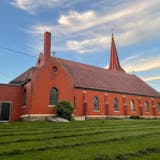I grew up just east of Sioux Falls, S.D. "Running into town" in the 1960s and '70s meant driving to the metropolis of 70,000 people.
It was the biggest city in South Dakota, North Dakota, Wyoming and Montana. Still is today, at 200,000. Its growth testifies to the geographical reality of the Northern Plains, but also to the origins of a city founded by the falls of the Big Sioux River.
"City of Hustle," an anthology of essays by a compelling array of (mostly) South Dakotans, is much like that river. It winds through curves that reflect a beloved children's park, indigenous Dakota history, a towering Catholic cathedral, an immense meatpacking plant, a stark-naked David, a thwarted George McGovern, an iconic Joe Foss (he invented the Super Bowl!), an infamous divorce colony and more.
Historian Jon K. Lauck, who with author Patrick Hicks collected these essays, notes how Sioux Falls' founding in 1877 was a case of perfect timing.
Railroads were booming, replacing a horse-drawn supply chain. Eastern cities had grappled with difficult issues such as sewage and fire control, enabling Sioux Falls to implement their solutions.
"Sioux Falls was … founded in an American republic that was fully formed and stable, nearly a century after the American Revolution," Lauck writes. While most of its residents came from Scandinavia and Germany, they didn't infuse the city with European influences as in the cities of the East and West. "Sioux Falls was clearly an American city in ways other cities were not."
Such city-centric books have, by nature, a somewhat limited audience. And it's tempting to think that you know pretty much all there is to know about where you grew up.
So it was fascinating to learn that the falls, remarkable in a river meandering across the prairie, never proved the economic powerhouse once imagined. While the Queen Bee Flour Mill could grind a lot of flour, it was far more than the drought-plagued land could produce. It closed after just two years.


